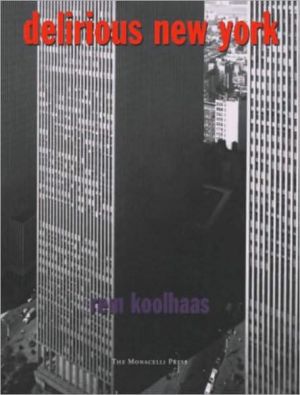

 |

|

The average rating for Delirious New York: A Retroactive Manifesto for Manhattan based on 2 reviews is 2.5 stars.
Review # 1 was written on 2008-06-02 00:00:00 Marc Russell Marc Russellpure unadulterated architectural self-aggrandizement. completely pretentious crap. some interesting material, but you have to wade through every other sentence of bullshit metaphysical declarations that this guy just pulls out of his ass. |
Review # 2 was written on 2017-06-14 00:00:00 GABRIEL BRANLY GABRIEL BRANLYI remember reading 'The Generic City' by Rem Koolhaas (pdf) when I was a masters student and greatly enjoying it. His analysis is entertainingly idiosyncratic and yet curiously illuminating. His selective account of New York's architectural history is likewise fragmentary yet instructive. It contains a wealth of strange anecdotes, a forest of illustrations, and several underlying theses about the nature of New York City. Inevitably, the most memorable elements are weird details, such as Gaudi's never-built skyscraper (pictured here), everything about Dreamland on Coney Island (which deserves the many pages Koolhaas devotes to it), the 1931 costume ball at which architects dressed as the skyscrapers they designed, and Dali's arrival in NYC: For shock effect on arrival, Dali decides to realise - retroactively - a Surrealist project originally intended to upset Paris, the baking of 'a fifteen metre loaf of bread'. The baker on board ship offers to bake a version 2.5 metres long (the maximum capacity of the ship's oven) with 'a wood armature inside it so that it would not break into two the moment it began to dry…' But when Dali disembarks an 'utterly disconcerting thing' happens: "Not one of the reporters [of a waiting group] asked me a single question about the loaf of bread which I held conspicuously during the whole interview either in my arm or resting on the ground as if it was a large cane…" The disconcerter disconcerted: Dali's first discovery is that in Manhattan Surrealism is invisible. His Reinforced Dough is just another false act among the multitudes. Theoretical points are raised in a similar, vaguely impressionistic fashion. The concept of 'reality shortage' was particularly intriguing, as were the culture of congestion and the analogy between hotels and movies. Much like Lefebvre in Writings on Cities, Koolhaas is no great fan of Le Corbusier, although he discusses his views on New York in some detail. This description is both acute and comical: The Parisian authorities do not take the Radiant proposal seriously. Their rejection forces Le Corbusier to become a Cartesian carpetbagger, peddling his horizontal glass Skyscraper like a furious prince dragging a colossal glass slipper on an Odyssey from Metropolis to Metropolis. The most alarming unrealised proposal in the whole book, though, is Harvey Wiley Corbett's vision of traffic planning. He thought not only that pedestrians should be relegated to first floor walkways to leave the entire street for cars, but that the front of buildings should be cut into for additional parking and traffic lanes, culminating in twenty lane streets. Can you imagine if this dystopian scheme had materialised. 'delirious new york' is by no means a systematic or full history of its architecture and planning, nor is it meant to be. Koolhaas provides detailed insight into the antecedents of iconic buildings such as the Rockefeller Centre and a real sense of the spirit of the city in the first three decades of the twentieth century, in his inimitable style. |
CAN'T FIND WHAT YOU'RE LOOKING FOR? CLICK HERE!!!